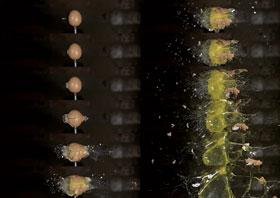

High-speed photography is the process of taking pictures of fast moving events, which are usually too fast for the human eye to see accurately. As technology develops and industrial processes like production lines get faster, errors and faults also occur at much higher speeds. High-speed photography allows scientists, maintenance engineers and designers to see what is happening, understand processes and troubleshoot problems by allowing a large number of clear informative pictures to be viewed of the events in troublesome areas.
The human eye is able to register and process around 25 pictures per second (pps). Faster than this, the eye is not able to notice individual pictures. However, many events are occurring so quickly that normal video taken at 25 pps does not give enough information. Furthermore, typically each picture would be exposed (think of old film cameras with shutter speed) for as long as possible, approximately 1/25th of a second. In fast moving lines however, 1/25th of a second can result in substantial movement during that exposure. The result of this is a blur of motion within each picture. High-speed photography serves to address this and other issues.
In a fast moving process, it is advantageous to have as many pictures per second as possible during an event, for example a bottle capping process going awry. The greater the number of pictures available, the shorter the physical distance travelled during each picture, during that second. This can allow millimetre by millimetre analysis of what is happening. This is in contrast to single shot images or strobe lit sequences from machine vision cameras. These, while often producing useful pictures, do not reveal what is happening between pictures as there is too much movement and time between each frame that is recorded. The net result is that often the cause of the problem is missed. The other advantage of high-speed cameras is that due to the number of pictures (frequently starting at 1000 pps) taken per second, the technology has had to adapt to ensuring that the exposure time per picture is kept to a minimum, yet still producing clear well exposed images. Typically, digital high-speed cameras today have minimum exposure times of 1-2 microseconds. Some can even go down to 300 nanoseconds. The very low exposure times keep that movement during the exposure to a minimum. The short exposure results in crisp, sharp edged images, which give great detail of the processes and movements.
Through the pictures aspects such as incorrect indexing, misaligned actuators, worn bearings and jumping conveyors can be pinpointed at the exact place of the fault. This allows diagnosis and therefore the solution, instead of hit-and-miss adjustments. High-speed photography can be used to trouble shoot processes such as filling, closing, packaging, label applications, printing and positioning.
In the pictures shown here, the pellet – seen in the first image just before the egg – is travelling at around 165 metres per second. The entire sequence of pictures from beginning to end took 0,024 seconds. It was filmed at 19 000 pps, with an exposure per picture of 16 microseconds.
For more information contact David Horne, Horne Technologies, +27 (0)76 563 2084, [email protected], www.hornet.cc
| Tel: | +27 76 563 2084 |
| Email: | [email protected] |
| www: | www.hornet.cc |
| Articles: | More information and articles about Horne Technologies |

© Technews Publishing (Pty) Ltd | All Rights Reserved